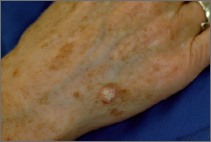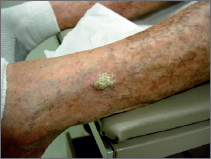What is squamous cell carcinoma (SCC)?
Squamous cell carcinoma
It's most often seen on sun-damaged skin. It's found mainly on sun-exposed areas—the face, especially the nose, the temples and forehead, and the lips.
It's also commonly noted on the bald areas of the scalp and the tops of ears in men, the top of the forearms and hands, and the sun-exposed areas of the neck.
In addition, it may also occur on any area that is repeatedly exposed to the sun.
Squamous cell carcinoma
Because SCC is related to sun exposure, it's noted more frequently in those with a greater degree of outdoor activity. It is seen in people who are fair-skinned, burn easily, and tan poorly.
It's more common in men, particularly those who work in outdoor occupations, such as farmers, sailors, and gardeners, and those who participate in outdoor sports.
Most often, a simple minor office procedure called electrodesiccation and curettage is performed for small growths and for very superficial SCCs, known as squamous cell carcinoma in situ.
Surgical excision is the preferred method for larger tumors.
Micrographic (Mohs') surgery may be the preferred method for recurrent or very large lesions. Mohs' surgery is a microscopically controlled method of removing skin cancers that allows for controlled excision and maximum preservation of normal skin. Excisions are repeated in the areas proven to be cancerous until a completely cancer-free specimen is obtained.
Keep in mind
Sometimes SCCs are considered more risky than basal cell carcinomas and so must be treated more carefully, and patients must be watched more closely afterward.
Also, certain types of SCCs, particularly the larger and deeply penetrating ones and those found next to or on mucous membranes, are considered more dangerous and must be treated more thoroughly.
Many people who say they “never go out in the sun” get SCCs, too; 5 minutes of sun a day adds up over 30 or 40 years.

